Abstract
The conformation of oxytocin is related to the evolution and to some of the biological activities of neurophypophyseal hormonal peptides. On the basis of the three-dimensional structure, positions 3, 4, 7, and 8 are the only loci at which naturally occurring neurohypophyseal peptides may be expected to differ. The side chains of these amino-acid residues are the primary determinants of the differential specificity in interactions between neurohypophyseal hormones and their receptors.
There are three general groups of structural modifications of neurohypophyseal hormones which can be correlated with specific changes in biological activity: (a) those affecting the stabilization of the backbone of the peptide, which would extensively perturb the spatial relationships among all the constituent amino acids and hence, affect both affinity and intrinsic activities uniformly; (b) those which, while retaining the stability of the backbone conformation, alter the steric environment and charge distribution of limited surface areas, and thereby can affect affinity and intrinsic activity differentially; and (c) those changing the steric and electronic requirements of moieties comprising the active surface of the neurohypophyseal peptide, without perturbing the peptide backbone of the hormone molecule and, hence, affecting intrinsic activity without altering affinity.
Full text
PDF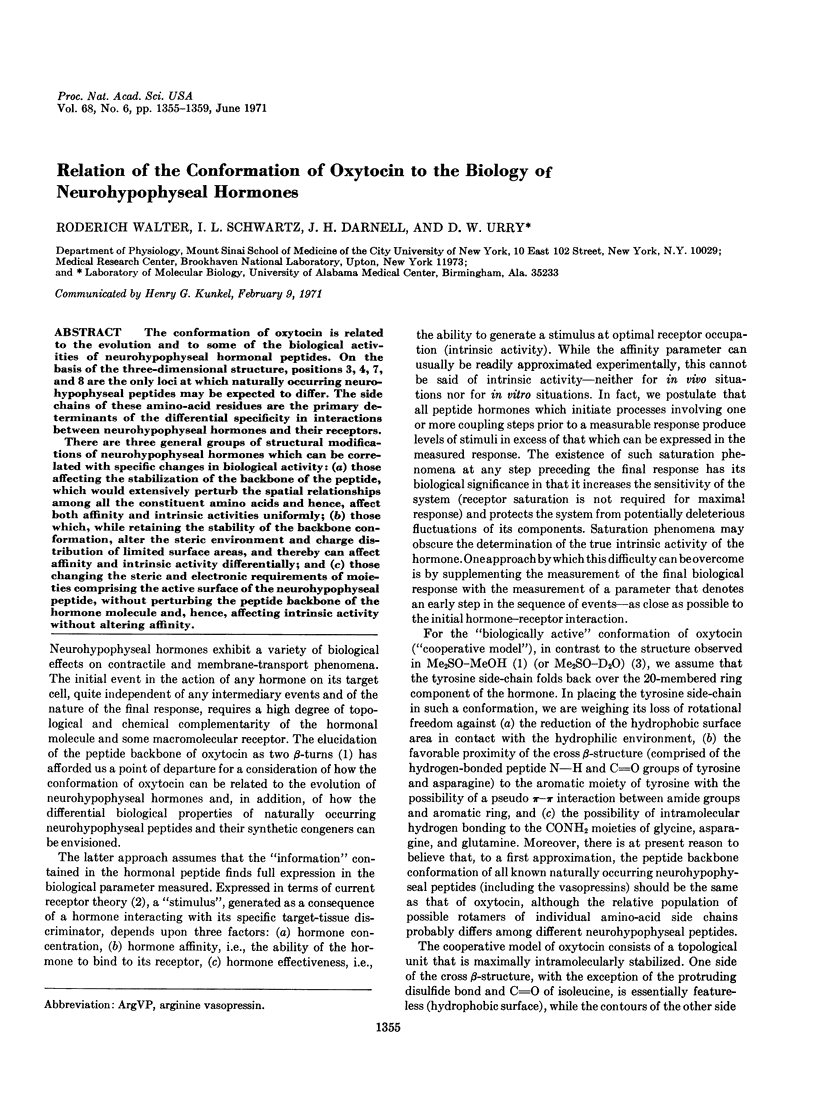
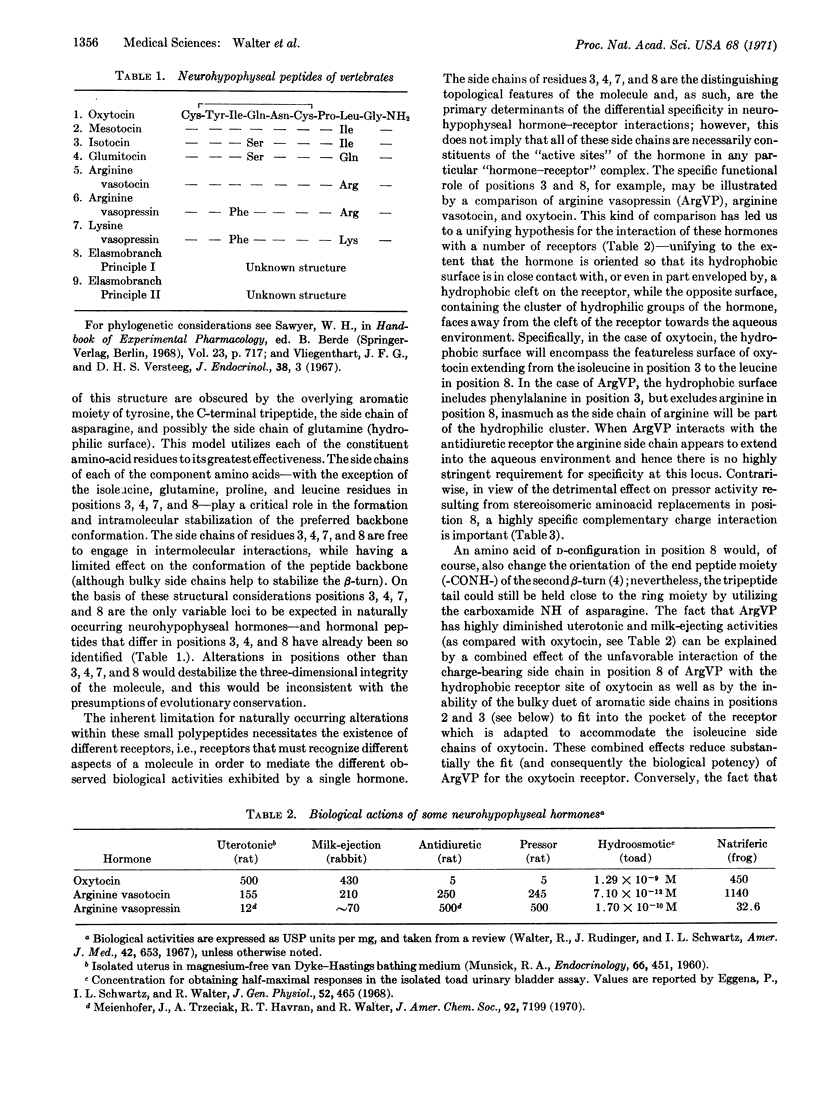
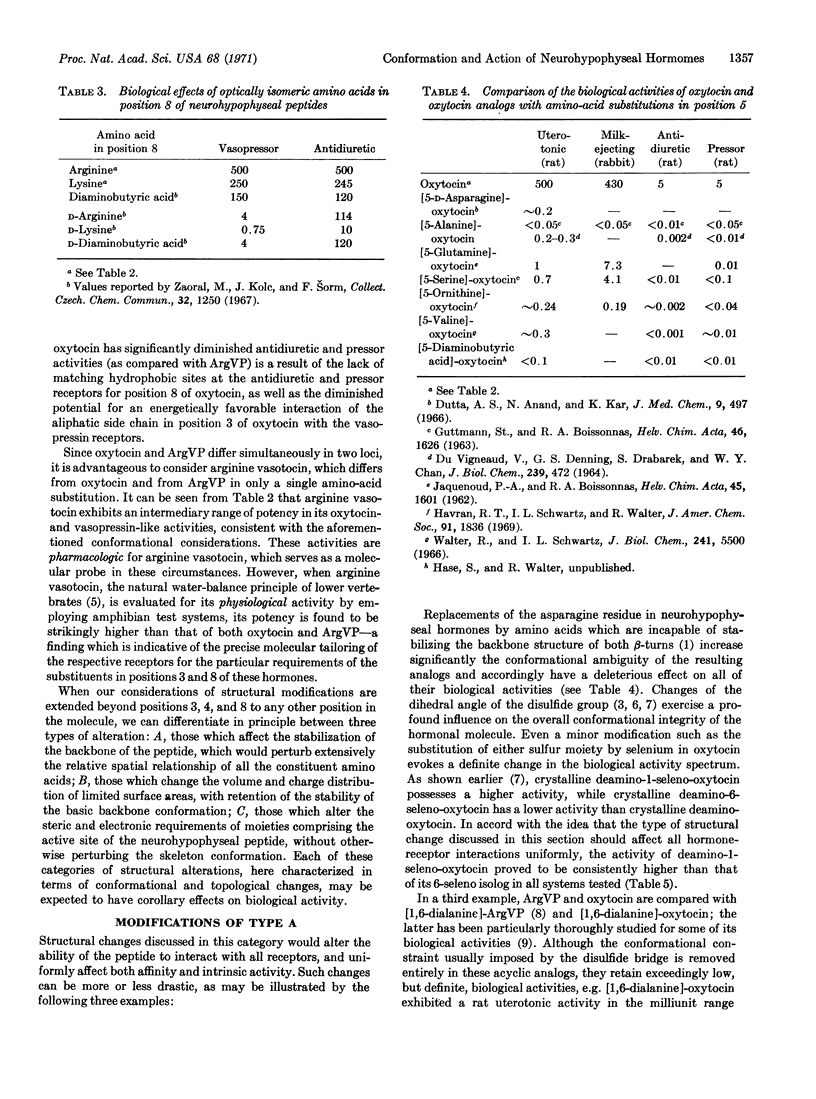
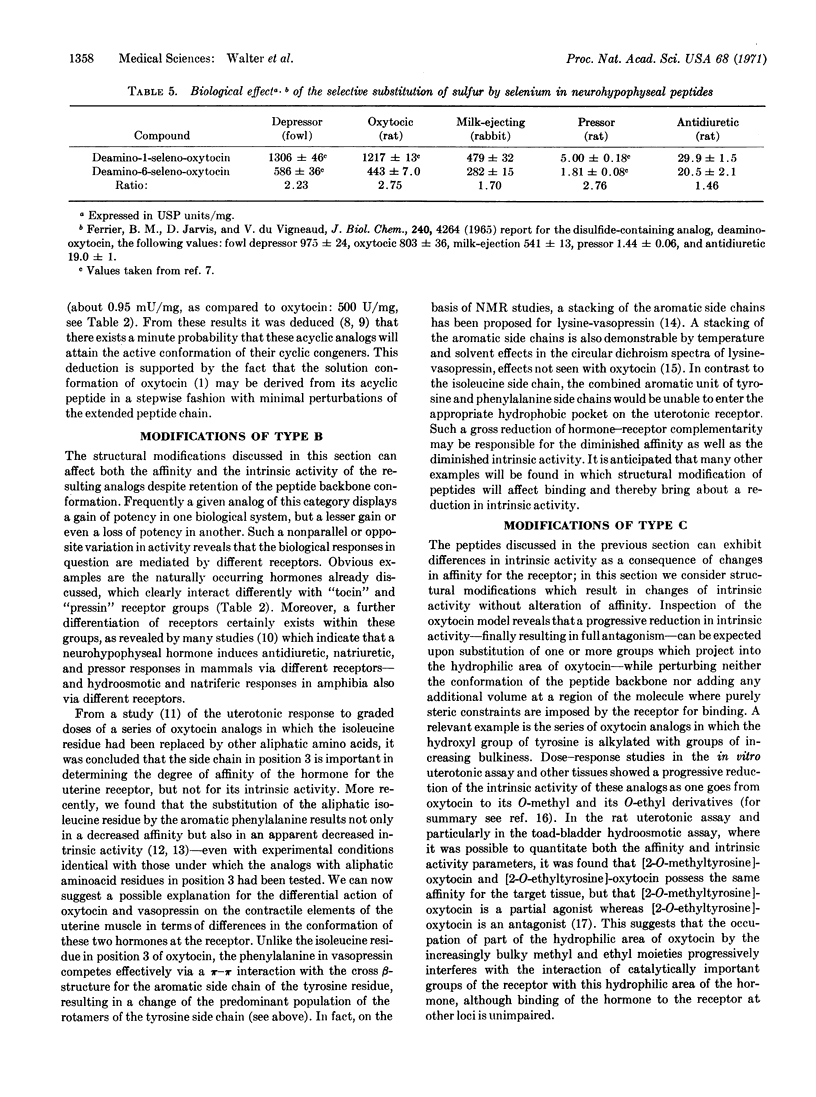
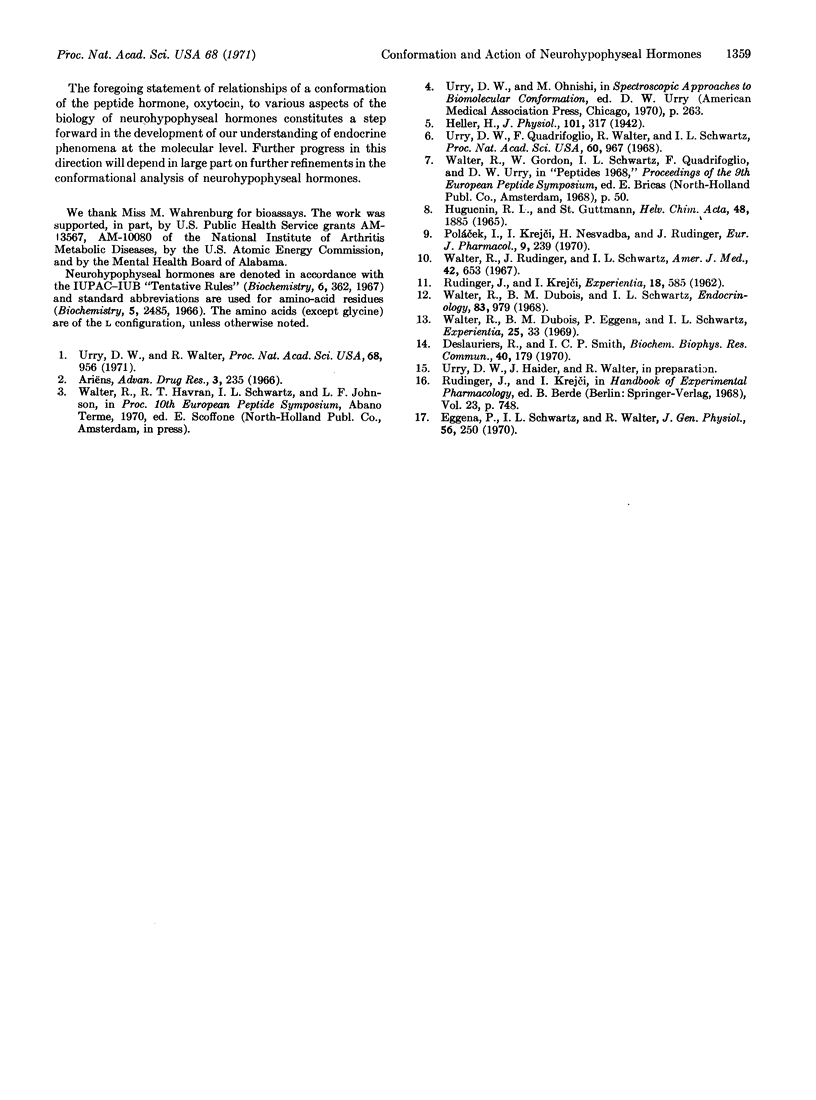
Selected References
These references are in PubMed. This may not be the complete list of references from this article.
- DUVIGNEAUD V., DENNING G. S., Jr, DRABAREK S., CHAN W. Y. THE SYNTHESIS AND PHARMACOLOGICAL STUDY OF 4-DECARBOXAMIDO-OXYTOCIN (4-ALPHA-AMINOBUTYRIC ACID-OXYTOCIN) AND 5-DECARBOXAMIDO-OXYTOCIN (5-ALANINE-OXYTOCIN). J Biol Chem. 1964 Feb;239:472–478. [PubMed] [Google Scholar]
- Deslauriers R., Smith I. C. Evidence from proton magnetic resonance data for the stacking of aromatic amino acids in lysine-vasopressin: comparison with oxytocin derivatives and related dipeptides. Biochem Biophys Res Commun. 1970 Jul 13;40(1):179–185. doi: 10.1016/0006-291x(70)91063-6. [DOI] [PubMed] [Google Scholar]
- Dutta A. S., Anand N., Kar K. Synthesis and pharmacological activity of 4-d-glutamine-oxytocin, 5-d-asparagine-oxytocin, and 4-d-glutamine-5-d-asparagine-oxytocin. J Med Chem. 1966 Jul;9(4):497–499. doi: 10.1021/jm00322a012. [DOI] [PubMed] [Google Scholar]
- Eggena P., Schwartz I. L., Walter R. A sensitive hydroosmotic toad bladder assay. Affinity and intrinsic activity of neurohypophyseal peptides. J Gen Physiol. 1968 Sep;52(3):465–481. doi: 10.1085/jgp.52.3.465. [DOI] [PMC free article] [PubMed] [Google Scholar]
- Eggena P., Schwartz I. L., Walter R. Threshold and receptor reserve in the action of neurohypophyseal peptides. A study of synergists and antagonists of the hydroosmotic response of the toad urinary bladder. J Gen Physiol. 1970 Aug;56(2):250–271. doi: 10.1085/jgp.56.2.250. [DOI] [PMC free article] [PubMed] [Google Scholar]
- Ferrier B. M., Jarvis D., Du Vigneaud V. Deamino-oxytocin. Its isolation by partition chromatography on Sephadex and crystallization from water, and its biological activities. J Biol Chem. 1965 Nov;240(11):4264–4266. [PubMed] [Google Scholar]
- Havran R. T., Schwartz I. L., Walter R. Oxytocin analogs with basic amino acid residues in positions 4 and 5. Synthesis and pharmacological properties of [4-ornithine]- and [5-ornithine]-oxytocin. J Am Chem Soc. 1969 Mar 26;91(7):1836–1840. doi: 10.1021/ja01035a040. [DOI] [PubMed] [Google Scholar]
- Heller H. The posterior pituitary principles of a species of reptile (Tropidonotus natrix) with some remarks on the comparative physiology of the posterior pituitary gland generally. J Physiol. 1942 Nov 30;101(3):317–326. doi: 10.1113/jphysiol.1942.sp003986. [DOI] [PMC free article] [PubMed] [Google Scholar]
- Huguenin R. L., Guttmann S. Synthèse de l'ala-1-ala-6-arg-8-vasopressine et de l'ala-1-ala-6-lys-8-vasopressine, ainsi que de la (désamino-ala)-1-ala-6-arg-8-vasopressine et de la (désamino-ala)-1-ala-6-lys-8-vasopressine. Helv Chim Acta. 1965 Dec 10;48(8):1885–1898. doi: 10.1002/hlca.19650480807. [DOI] [PubMed] [Google Scholar]
- Meienhofer J., Trzeciak A., Havran R. T., Walter R. A solid-phase synthesis of (8-arginine)-vasopressin through a crystalline protected nonapeptide intermediate and biological properties of the hormone. J Am Chem Soc. 1970 Dec 2;92(24):7199–7202. doi: 10.1021/ja00727a031. [DOI] [PubMed] [Google Scholar]
- Polácek I., Krejcí I., Nesvadba H., Rudinger J. Action of (1,6-di-alanine)-oxytocin and (1,6-di-serine)-oxytocin on the rat uterus and mammary gland in vitro. Eur J Pharmacol. 1970 Feb;9(2):239–245. doi: 10.1016/0014-2999(70)90306-7. [DOI] [PubMed] [Google Scholar]
- RUDINGER J., KREJCI I. Dose-response relations for some synthetic analogues of oxytocin, and the mode of action of oxytocin on the isolated uterus. Experientia. 1962 Dec 15;18:585–588. doi: 10.1007/BF02172197. [DOI] [PubMed] [Google Scholar]
- Urry D. W., Quadrifoglio F., Walter R., Schwartz I. L. Conformational studies on neurohypophyseal hormones: the disulfide bridge of oxytocin. Proc Natl Acad Sci U S A. 1968 Jul;60(3):967–974. doi: 10.1073/pnas.60.3.967. [DOI] [PMC free article] [PubMed] [Google Scholar]
- Urry D. W., Walter R. Proposed conformation of oxytocin in solution. Proc Natl Acad Sci U S A. 1971 May;68(5):956–958. doi: 10.1073/pnas.68.5.956. [DOI] [PMC free article] [PubMed] [Google Scholar]
- Walter R., Dubois B. M., Eggena P., Schwartz I. L. Comparison of the mode of action of oxytocin and lysine-vasopressin on the isolated rat uterus. Experientia. 1969 Jan 15;25(1):33–34. doi: 10.1007/BF01903876. [DOI] [PubMed] [Google Scholar]
- Walter R., Dubois B. M., Schwartz I. L. Biological significance of the amino acid residue in position 3 of neurohypophyseal hormones and the effect of magnesium on their uterotonic action. Endocrinology. 1968 Nov;83(5):979–983. doi: 10.1210/endo-83-5-979. [DOI] [PubMed] [Google Scholar]
- Walter R., Rudinger J., Schwartz I. L. Chemistry and structure-activity relations of the antidiuretic hormones. Am J Med. 1967 May;42(5):653–677. doi: 10.1016/0002-9343(67)90087-3. [DOI] [PubMed] [Google Scholar]
- Walter R., Rudinger J., Schwartz I. L. Chemistry and structure-activity relations of the antidiuretic hormones. Am J Med. 1967 May;42(5):653–677. doi: 10.1016/0002-9343(67)90087-3. [DOI] [PubMed] [Google Scholar]
- Walter R., Schwartz I. L. 5-Valine-oxytocin and 1-deamino-5-valine-oxytocin. Syntheses and some pharmacological properties. J Biol Chem. 1966 Dec 10;241(23):5500–5503. [PubMed] [Google Scholar]


